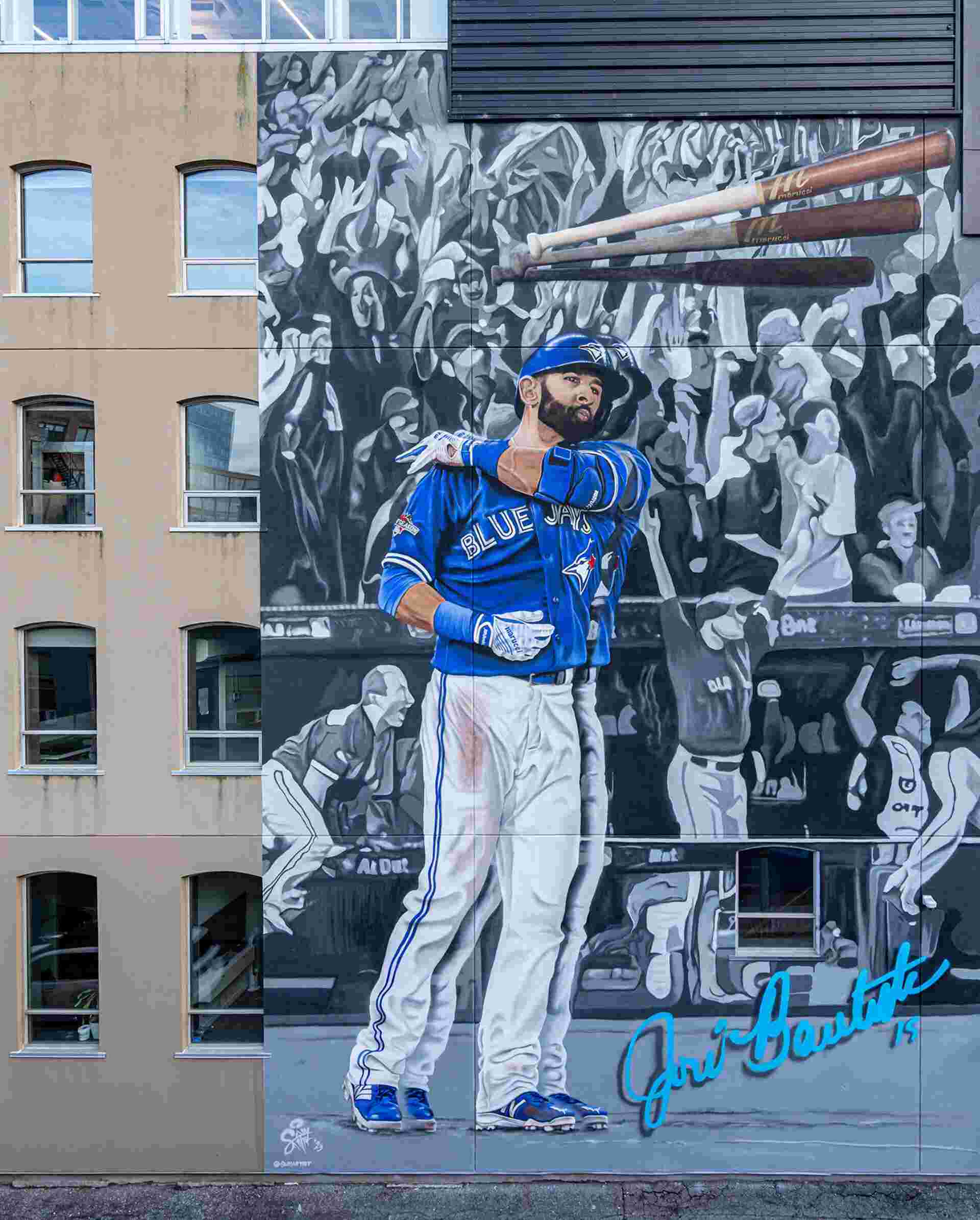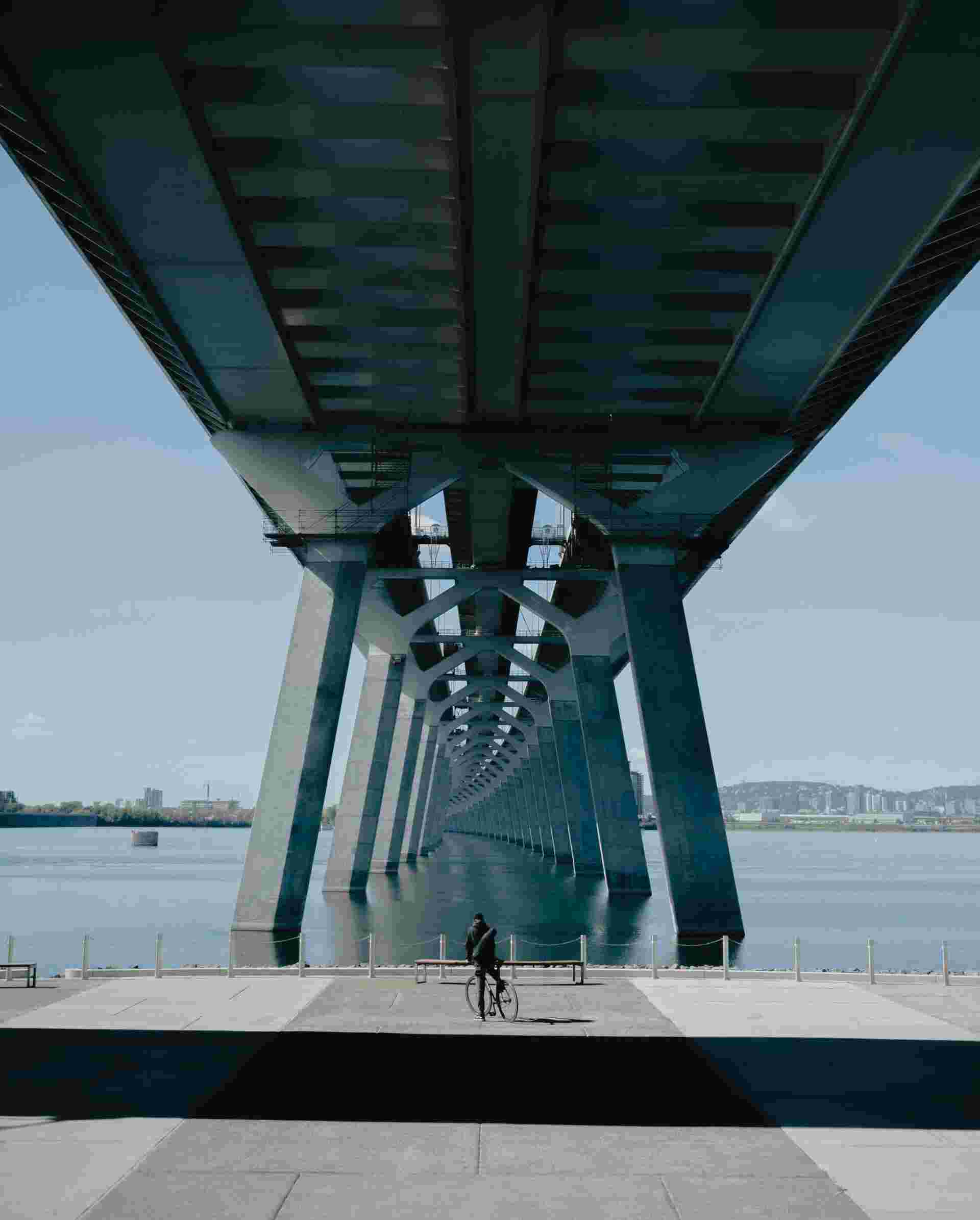
Freeze Frame
Make room for the arts Sum Artist’s José Bautista mural at 99 Spadina.
BY MAGALI BEBRONNE AND DAVID BEITEL
AS TOLD TO DANIEL BROMBERG

Magali Bebronne: There are various reasons why Montreal is one of the biggest cycling cities in North America. There’s really a cycling culture that exists here. It’s not only a good cycling city, but also a city of cyclists. Data tells us that one in seven people in Montreal cycled on a daily basis in 2018. The numbers from 2023 should be even more impressive, as the pandemic gave cycling rates a huge boost.
David Beitel: The city made an important push in the late 2000s by building safe-cycling infrastructure in downtown areas that were some of the first fully protected cycling lanes in North America. This project required a lot of political courage at the time, being implemented at the expense of [car] lanes or parking spaces. By 2010, Montreal was counting over a million bike trips in the main downtown corridor. These were big numbers. A million cyclists a year is a significant number of users, all travelling safely.
In some ways, [the city] fell victim to its own success. Despite it being a very efficient way of moving people, when you’re pushing a thousand people through a three-metre-wide corridor in a one-hour peak period, there’s bound to be congestion. The city took it a step further by committing to build a new type of infrastructure, the REV [Réseau Express Vélo], a network of unidirectional cycling lanes with two-and-a-half-metre-wide allowances on either side of the road to accommodate different cyclists pedalling at different speeds, and in even greater volumes.
MB: Any new bike infrastructure project undoubtedly causes a lot of friction. If you listen to elected officials or attend international forums, you realize there’s no way of avoiding it. Whether you’re eliminating two parking spots or 200, you’ll have the same kind of “bike-lash,” so might as well make it worth it. Be brave and go for the projects that are really going to be game changers. And we’re seeing that the REV created a new standard for what bike infrastructure should be.
DB: We’re seeing a big increase in cycling, with data showing there are a lot of new bike trips being generated when you provide direct and safe routes from major population centres of the city to others. And it ultimately shows that we’re creating new options for people to use the transportation mode of their choice—one that works for them. The REV and facilities like it are moving us in that direction.
“[Montreal] is not only a good cycling city, but also a city of cyclists.”
MB: The number of serious injuries among cyclists has dropped 62 percent since 2020, all while having 29 percent more cyclists and 51 percent more cars on the roads. The key is that the physical cycling network grew by 111 percent. The city now says its network extends 901 kilometres, which is mostly cleared in the winter. It proves that developing safe infrastructure keeps people safe.
DB: Right. Evidence shows that if you increase the number of cyclists but improve the infrastructure, certain designs help reduce collision frequency. Speed is a major player in terms of the severity of the injury, so if we can provide designs that reduce speeds at turning locations and intersections, it has a huge impact on the severity of collisions when they do occur.
MB: There are also indicators like BIXI, a public bicycle-sharing system and great local success story. Each year BIXI is adding more stations and breaking ridership records. Some suburbs are being very ambitious in the number of shared bikes made available, understanding this is an effective mobility option.
DB: It’s true. We often talk about cycling as a “central borough” thing, but it’s catching on in suburban municipalities and boroughs, too.
It creates a virtuous cycle: Good infrastructure breeds good behaviour. I believe we’re now designing and implementing bike facilities that are conducive to safer behaviour.
MB: Beyond safety, many international studies show how increasing access for pedestrians and cyclists helps boost economic activity.
DB: There’s been no major loss of users on Saint-Denis Street after the REV opened. In fact, the evidence shows it’s been quite good for commercial real estate, and, for the most part, businesses seem to be thriving. Vacancy rates have tumbled, and the number of transactions—and their values—have increased compared to arteries that don’t have similar bike infrastructure.
MB: Tourists are also embracing these new facilities. It was remarkable how many online content creators featured the urban landscape last summer. In particular, pedestrianized streets got a lot of clout, and people overall were amazed at the vibrancy and the experience on Mont-Royal Avenue and several other commercial streets. These are the kinds of initiatives that can put us on the map.
DB: BIXI’s most popular day last year was Saturday, May 27, with 67,000 bike trips occurring. The greatest use of bike infrastructure is typically on weekdays, so the fact that the top day was on a weekend suggests there’s a good proportion of [people engaging in] recreational use. It’s a great way to improve and increase tourism across the city, undeniably.
MB: Having already accomplished so much, we now need to go beyond the central neighbourhoods. The city has a great vision for 2027, aiming to provide safe bike infrastructure and new transportation options in other neighbourhoods, and to different segments of the population.
DB: With more bike infrastructure in the suburbs, we’ll naturally see more people choosing to bike. I expect to see an explosion of cyclists in those locations—at least relative to what we’re seeing today—and that will be an indicator that the seeds we’re planting today yield great results in the next five years.